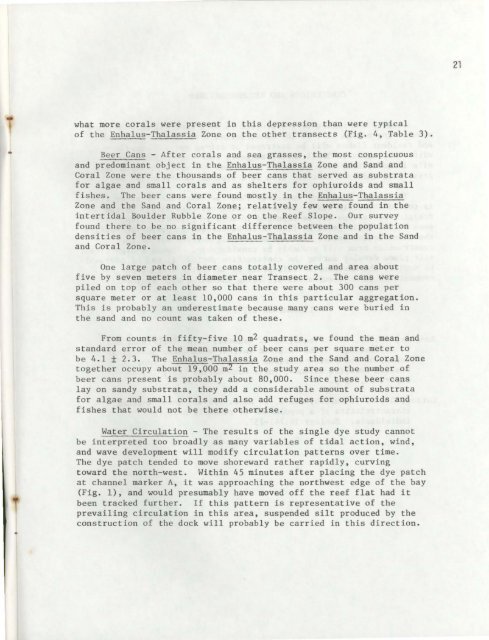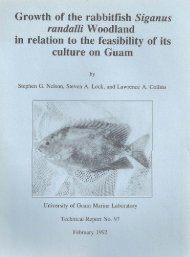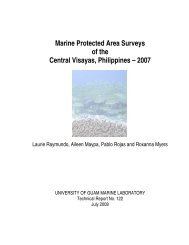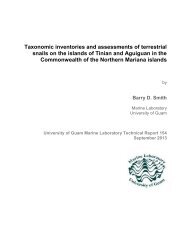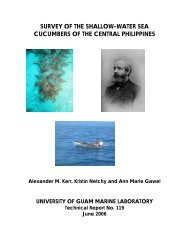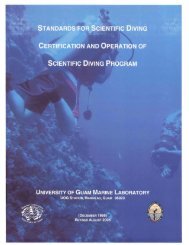MARINE BIOLOGICAL SURVEY OF THE PROPOSED DOCK SITE ...
MARINE BIOLOGICAL SURVEY OF THE PROPOSED DOCK SITE ...
MARINE BIOLOGICAL SURVEY OF THE PROPOSED DOCK SITE ...
Create successful ePaper yourself
Turn your PDF publications into a flip-book with our unique Google optimized e-Paper software.
21- what more corals were present in this depression than were typicalof the Enhalus-Thalassia Zone On the other transects (Fig. 4, Table 3).Beer Cans - After corals and sea grasses, the most conspicuousand predominant object in the Enhalus-Thalassia Zone and Sand andCoral Zone were the thousands of beer cans that served as substratafor algae and small corals and as shelters for ophiuroids and smallfishes. The beer cans were found mostly in the Enhalus-ThalassiaZone and the Sand and Coral Zone; relatively few were found in theintertidal Boulder Rubble Zone or on the Reef Slope. Our surveyfound there to be no significant difference between the populationdensities of beer cans in the Enhalus-Thalassia Zone and in the Sandand Coral Zone.One large patch of beer cans totally covered and area aboutfive by seven meters in diameter near Transect 2. The cans werepiled on top of each other so that there were about 300 cans persquare meter or at least 10,000 cans in this particular aggregation.This is probably an underestimate because many cans were buried inthe sand and no count was taken of these.From counts in fifty-five 10 m2 quadrats, we found the mean andstandard error of the mean number of beer cans per square meter tobe 4.1 ± 2.3. The Enhalus-Thalassia Zone and the Sand and Coral Zonetogether occupy about 19,000 mZ in the study area so the number ofbeer cans present is probably about 80,000. Since these beer canslay on sandy substrata, they add a considerable amount of substratafor algae and small corals and also add refuges for ophiuroids andfishes that would not be there otherwise.Water Circulation - The results of the single dye study cannotbe interpreted too broadly as many variables of tidal action, wind,and wave development will modify circulation patterns over time.The dye patch tended to move shoreward rather rapidly, curvingtoward the north-west. Within 4S minutes after placing the dye patchat channel marker A, it was approaching the northwest edge of the bay(Fig. 1), and would presumably have moved off the reef flat had itbeen tracked further. If this pattern is representative of theprevailing circulation in this area, suspended silt produced by theconstruction of the dock will probably be carried in this direction.


